
- 阻害剤
- 研究分野別
- PI3K/Akt/mTOR
- Epigenetics
- Methylation
- Immunology & Inflammation
- Protein Tyrosine Kinase
- Angiogenesis
- Apoptosis
- Autophagy
- ER stress & UPR
- JAK/STAT
- MAPK
- Cytoskeletal Signaling
- Cell Cycle
- TGF-beta/Smad
- 化合物ライブラリー
- Popular Compound Libraries
- Customize Library
- Clinical and FDA-approved Related
- Bioactive Compound Libraries
- Inhibitor Related
- Natural Product Related
- Metabolism Related
- Cell Death Related
- By Signaling Pathway
- By Disease
- Anti-infection and Antiviral Related
- Neuronal and Immunology Related
- Fragment and Covalent Related
- FDA-approved Drug Library
- FDA-approved & Passed Phase I Drug Library
- Preclinical/Clinical Compound Library
- Bioactive Compound Library-I
- Bioactive Compound Library-II
- Kinase Inhibitor Library
- Express-Pick Library
- Natural Product Library
- Human Endogenous Metabolite Compound Library
- Alkaloid Compound LibraryNew
- Angiogenesis Related compound Library
- Anti-Aging Compound Library
- Anti-alzheimer Disease Compound Library
- Antibiotics compound Library
- Anti-cancer Compound Library
- Anti-cancer Compound Library-Ⅱ
- Anti-cancer Metabolism Compound Library
- Anti-Cardiovascular Disease Compound Library
- Anti-diabetic Compound Library
- Anti-infection Compound Library
- Antioxidant Compound Library
- Anti-parasitic Compound Library
- Antiviral Compound Library
- Apoptosis Compound Library
- Autophagy Compound Library
- Calcium Channel Blocker LibraryNew
- Cambridge Cancer Compound Library
- Carbohydrate Metabolism Compound LibraryNew
- Cell Cycle compound library
- CNS-Penetrant Compound Library
- Covalent Inhibitor Library
- Cytokine Inhibitor LibraryNew
- Cytoskeletal Signaling Pathway Compound Library
- DNA Damage/DNA Repair compound Library
- Drug-like Compound Library
- Endoplasmic Reticulum Stress Compound Library
- Epigenetics Compound Library
- Exosome Secretion Related Compound LibraryNew
- FDA-approved Anticancer Drug LibraryNew
- Ferroptosis Compound Library
- Flavonoid Compound Library
- Fragment Library
- Glutamine Metabolism Compound Library
- Glycolysis Compound Library
- GPCR Compound Library
- Gut Microbial Metabolite Library
- HIF-1 Signaling Pathway Compound Library
- Highly Selective Inhibitor Library
- Histone modification compound library
- HTS Library for Drug Discovery
- Human Hormone Related Compound LibraryNew
- Human Transcription Factor Compound LibraryNew
- Immunology/Inflammation Compound Library
- Inhibitor Library
- Ion Channel Ligand Library
- JAK/STAT compound library
- Lipid Metabolism Compound LibraryNew
- Macrocyclic Compound Library
- MAPK Inhibitor Library
- Medicine Food Homology Compound Library
- Metabolism Compound Library
- Methylation Compound Library
- Mouse Metabolite Compound LibraryNew
- Natural Organic Compound Library
- Neuronal Signaling Compound Library
- NF-κB Signaling Compound Library
- Nucleoside Analogue Library
- Obesity Compound Library
- Oxidative Stress Compound LibraryNew
- Phenotypic Screening Library
- PI3K/Akt Inhibitor Library
- Protease Inhibitor Library
- Protein-protein Interaction Inhibitor Library
- Pyroptosis Compound Library
- Small Molecule Immuno-Oncology Compound Library
- Mitochondria-Targeted Compound LibraryNew
- Stem Cell Differentiation Compound LibraryNew
- Stem Cell Signaling Compound Library
- Natural Phenol Compound LibraryNew
- Natural Terpenoid Compound LibraryNew
- TGF-beta/Smad compound library
- Traditional Chinese Medicine Library
- Tyrosine Kinase Inhibitor Library
- Ubiquitination Compound Library
-
Cherry Picking
You can personalize your library with chemicals from within Selleck's inventory. Build the right library for your research endeavors by choosing from compounds in all of our available libraries.
Please contact us at info@selleck.co.jp to customize your library.
You could select:
- 抗体
- 新製品
- お問い合わせ
PARP
亜型選択性的な製品
PARP製品
- All (57)
- PARP阻害剤 (51)
- PARPモジュレータ(3)
- 新製品
| 製品コード | 製品名称 | 製品説明 | 文献中Selleckの製品使用例 | お客様のフィードバック |
|---|---|---|---|---|
| S1060 | Olaparib (AZD2281) | オラパリブ (Olaparib (AZD2281, KU0059436)) は選択的 PARP1/2 阻害剤であり、cell-free assay における IC50 はそれぞれ 5 nM および 1 nM です。タンキラーゼ-1 (Tankyrase-1) に対しては 1/300 の効果を示します。オラパリブは BRCA に変異をきたした細胞において、マイトファジー (mitophagy) に関連した顕著なオートファジー (mitophagy) を誘発します。 |
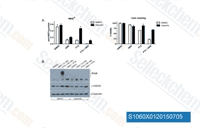
|
|
| S1180 | XAV-939 | XAV-939 (NVP-XAV939) selectively inhibits Wnt/β-catenin-mediated transcription through tankyrase1/2 inhibition with IC50 of 11 nM/4 nM in cell-free assays, regulates axin levels and does not affect CRE, NF-κB or TGF-β. |
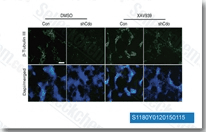
|
|
| S1004 | Veliparib (ABT-888) | Veliparib (ABT-888, NSC 737664) is a potent inhibitor of PARP1 and PARP2 with Ki of 5.2 nM and 2.9 nM in cell-free assays, respectively. It is inactive to SIRT2. Veliparib increases autophagy and apoptosis. Phase 3. |
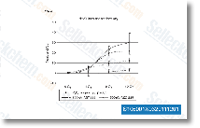
|
|
| S7048 | Talazoparib (BMN-673) | タラゾパリブ (Talazoparib (BMN 673、LT-673)) は、新規 PARP 阻害剤 (無細胞アッセイで IC50 = 0.57 nM) です。 また PARP-2 の強力な阻害剤でもありますが、PARG を阻害せず PTEN 変異に非常に敏感です。 臨床フェーズ 3。 |
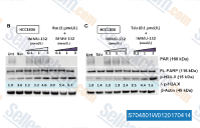
|
|
| S1098 | Rucaparib phosphate | Rucaparib phosphate is an inhibitor of PARP with Ki of 1.4 nM for PARP1 in a cell-free assay, also showing binding affinity to eight other PARP domains. Phase 3. |
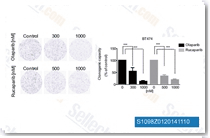
|
|
| S2741 | Niraparib (MK-4827) | ニラパリブ (Niraparib (MK-4827)) は PARP1/2 の選択的阻害剤 (IC50 = 3.8 nM/2.1 nM) であり、変異型 BRCA-1 および BRCA-2 を持つ癌細胞で高い活性を示します。PARP3, V-PARP, Tank1 に比べて 330 倍以上の選択性があります。 ニラパリブは PARP-DNA 複合体を形成し、DNA損傷、アポトーシス (apoptossis)、および細胞死を引き起こします。臨床フェーズ 3。 |

|
|
| S7300 | PJ34 HCl | PJ34 HCl is the hydrochloride salt of PJ34, which is a PARP inhibitor with EC50 of 20 nM and is equally potent to PARP1/2. |

|
|
| S4948 | Rucaparib (AG014699) | Rucaparib is an inhibitor of PARP with Ki of 1.4 nM for PARP1 in a cell-free assay, also showing binding affinity to eight other PARP domains. | ||
| S7625 | Niraparib tosylate | Niraparib tosylate is a selective inhibitor of PARP1/PARP2 with IC50 of 3.8 nM/2.1 nM. Niraparib increases formation of PARP-DNA complexes resulting in DNA damage, apoptosis, and cell death. |
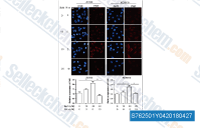
|
|
| S2178 | AG-14361 | AG14361 is a potent inhibitor of PARP1 with Ki of <5 nM in a cell-free assay. It is at least 1000-fold more potent than the benzamides. |
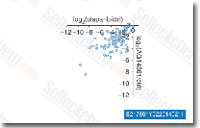
|
|
| S1087 | Iniparib (BSI-201) | Iniparib (BSI-201, NSC-746045, IND-71677) is a PARP1 inhibitor with demonstrated effectiveness in triple-negative breast cancer (TNBC). Phase 3. |
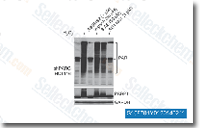
|
|
| S5195 | Rucaparib Camsylate | Rucaparib (Rubraca, AG014699, PF01367338) Camsylate is an inhibitor of PARP with Ki of 1.4 nM for PARP1 in a cell-free assay, also showing binding affinity to eight other PARP domains. | ||
| S2197 | A-966492 | A-966492 is a novel and potent inhibitor of PARP1 and PARP2 with Ki of 1 nM and 1.5 nM, respectively. |
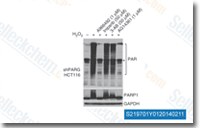
|
|
| S7239 | G007-LK | G007-LK is a potent and selective tankyrase inhibitor with IC50 of 46 nM and 25 nM for TNKS1/2, respectively. |
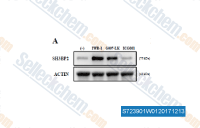
|
|
| S8038 | UPF 1069 | UPF 1069 is a selective PARP2 inhibitor with IC50 of 0.3 μM. It is ~27-fold selective against PARP1. | ||
| S7029 | AZD2461 | AZD2461 is a novel PARP inhibitor with low affinity for Pgp. Phase 1. |
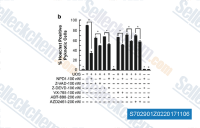
|
|
| S8592 | Pamiparib | Pamiparib is a potent and selective inhibitor of PARP1 and PARP2 with IC50 values of 0.83 and 0.11 nM, respectively in biochemical assays. It shows high selectivity over other PARP enzymes. | ||
| S1132 | 3-Aminobenzamide | 3-Aminobenzamide (3-ABA , 3-Amino Benzamide, 3-AB) is a potent inhibitor of Poly(ADP-ribose)polymerase (PARP) and inhibits cell apoptosis after SCI (Spinal Cord Injury) in caspase-independent way. |
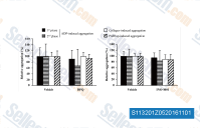
|
|
| S7438 | ME0328 | ME0328 is a potent and selective PARP inhibitor with IC50 of 0.89 μM for PARP3, about 7-fold selectivity over PARP1. |
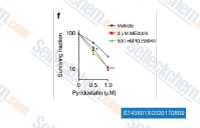
|
|
| S8363 | NMS-P118 | NMS-P118 is a potent, orally available, and highly selective PARP-1 inhibitor endowed with excellent ADME and pharmacokinetic profiles, showing 150-fold selectivity for PARP-1 over PARP-2 (Kd 0.009 μM vs 1.39 μM, respectively). | ||
| S8419 | Stenoparib (E7449) | Stenoparib (E7449, 2X-121, MGI25036) is an orally bioavailable, brain penetrable, small molecule dual inhibitor of PARP1/2 and also inhibits PARP5a/5b, otherwise known as tankyrase1 and 2 (TNKS1/2), important regulators of canonical Wnt/β-catenin signaling. It has IC50 values of 1.0 and 1.2 nM for PARP1 and 2, respectively. | ||
| S7238 | NVP-TNKS656 | NVP-TNKS656 is a highly potent, selective, and orally active tankyrase inhibitor with IC50 of 6 nM for TNKS2, > 300-fold selectivity against PARP1 and PARP2. | ||
| S7490 | WIKI4 | WIKI4 is a novel Tankyrase inhibitor with IC50 of 15 nM for TNKS2, and leads to inhibition of Wnt/beta-catenin signaling. | ||
| S4715 | Benzamide | Benzamide, an inhibitor of poly(ADP-ribose) polymerase, is a derivative of benzoic acid. | ||
| S8370 | BGP-15 2HCl | BGP-15, is a nicotinic amidoxime derivative with PARP inhibitory activity. It has been demonstrated that BGP-15 protects against ischemia-reperfusion injury. | ||
| S7730 | NU1025 | NU1025 (NSC 696807) is a potent PARP inhibitor with IC50 of 400 nM. | ||
| S5967 | Berberine chloride hydrate | Berberine (Natural Yellow 18) chloride hydrate is a quaternary ammonium salt from the group of isoquinoline alkaloids. Berberine activates caspase 3 and caspase 8, cleavage of poly ADP-ribose polymerase (PARP) and the release of cytochrome c. Berberine chloride decreases the expression of c-IAP1, Bcl-2 and Bcl-XL. Berberine chloride induces apoptosis with sustained phosphorylation of JNK and p38 MAPK, as well as generation of the ROS. Berberine chloride is a dual topoisomerase I and II inhibitor. Berberine chloride is also a potential autophagy modulator. | ||
| S6745 | JW55 | JW55 is a potent and selective inhibitor of the canonical Wnt pathway that functions via inhibition of the PARP domain of tankyrase 1 and tankyrase 2 (TNKS1/2). | ||
| S0519 | BYK204165 | BYK204165 is a potent and selective inhibitor of the poly(ADP-ribose) polymerase (PARP). BYK204165 inhibits cell-free recombinant human PARP-1 (hPARP-1) with pIC50 of 7.35 and pKi of 7.05 and murine PARP-2 (mPARP-2) with pIC50 of 5.38, respectively. | ||
| S9712 | Fluzoparib (SHR-3162) | Fluzoparib (SHR3162, HS10160) is a potent Poly (ADP-ribose) polymerase (PARP) inhibitor that shows anti-tumor activity with an IC50 of 1.46±0.72 nM for PARP1. |
||
| S4710 | Picolinamide | Picolinamide (2-Pyridinecarboxamide, Picolinoylamide, 2-Carbamoylpyridine) is found to be a strong inhibitor of poly (ADP-ribose) synthetase of nuclei from rat pancreatic islet cells. | ||
| F0136 | Cleaved PARP (Asp214) Antibody [M18N4] | Cleaved PARP (Asp214) Rabbit mAb recognizes endogenous levels of total Cleaved PARP (Asp214) protein. | ||
| F0148 | PARP1 Antibody [N4A5] | PARP1 Rabbit mAb recognizes endogenous levels of total PARP1 protein. | ||
| F2623 | PARP1 Antibody [F9N15] | |||
| E1425 | Nesuparib | Nesuparib (JPI-547, NOV140201) is a potential inhibitor of both PARP and tankyrases, with IC50 of 0.005 μM, 0.001 μM, 0.002 μM, and ND for TNKS1, TNKS2, PARP1, and PARP2, respectively. Nesuparib exhibits anti-tumor activity in BRCA-deficient xenograft models. | ||
| S6899 | Licochalcone D | Licochalcone D (Lico D, LCD, LD), a flavonoid isolated from a Chinese medicinal plant Glycyrrhiza inflata, has antioxidant, anti-inflammatory and anti-cancer properties. Licochalcone D inhibit phosphorylation of NF-κB p65 in LPS signaling pathway. Licochalcone D inhibits JAK2, EGFR and Met (c-Met) activities and induces ROS-dependent apoptosis. Licochalcone D also induces caspases activation and poly (ADP-ribose) polymerase (PARP) cleavage. | ||
| S6977 | DR2313 | DR2313 is a potent, selective, competitive and brain-penetrant inhibitor of poly(ADP-ribose) polymerase (PARP), with IC50s of 0.20 μM and 0.24 μM for PARP-1 and PARP-2, respectively. | ||
| S6739 | MN 64 | MN-64 is a potent inhibitor of TNKS1 and TNKS2 with IC50 value of 6 and 72 nM, respectively. | ||
| S0913 | 4',5,7-Trimethoxyflavone | 4',5,7-Trimethoxyflavone (5,7,4'-Trimethoxyflavone, TMF) is a flavonoid isolated from Kaempferia parviflora (KP) that induces apoptosis. 4',5,7-Trimethoxyflavone increases sub-G1 phase, DNA fragmentation, annexin-V/PI staining and Bax/Bcl-xL ratio, activates caspase-3 and degrades poly (ADP-ribose) polymerase (PARP) protein. | ||
| E5842New | Nudifloramide | Nudifloramide (2PY, N-methyl-2-pyridone-5- carboxamide) is a pyridine derivative of nicotinamide that inhibits PARP-1 (poly (ADP-ribose) polymerase-1) activity in vitro, with an IC50 of 8 µM. | ||
| E1069 | M2912 | M2912 (MSC2504877) is a very potent TNKS1/TNKS2 inhibitor (IC50=0.6 nM for TNKS1) with exquisite selectivity over other PARP family enzymes and favorable compound properties. This inhibitor potently modulates the Wnt/β-catenin pathway by elevating the levels of axin2 (EC50=17 nM) and tankyrase in DLD1 cells in a dose-dependent manner resulting in reduced cellular Wnt reporter activity. | ||
| S0732 | GeA-69 | GeA-69 is a cell-permeable, selective allosteric inhibitor targeting macrodomain 2 (MD2) of poly-adenosine-diphosphate-ribose polymerase 14 (PARP14) with Kd of 860 nM. | ||
| S8993 | Atamparib (RBN-2397) | Atamparib (RBN-2397) is a potent, selective and orally active NAD+ competitive inhibitor PARP7 with IC50 of <3 nM and Kd of <0.001 μM. RBN-2397 has the potential for the research of tumor treatment. | ||
| E1614 | OUL232 | OUL232 (Compound 27) is an potent inhibitor of mono-ADP-ribosylation (mono-ARTs) PARP10 with IC50 of 7.8 nM. It also inhibits PARP7, PARP11, PARP12, PARP14, and PARP15 at nM potencies. | ||
| S9893 | Venadaparib(IDX-1197) | Venadaparib (IDX-1197), a potent PARP1/2 inhibitor with IC50 values of 1.4 nM and 1.0 nM respectively, prevents the repair of DNA single-strand breaks (SSB) and promotes the conversion of SSB to double-stranded breaks (DSB), which ultimately leads to synthetic lethality in cancer cells. | ||
| S2271 | Berberine chloride | Berberine chloride is a quaternary ammonium salt from the group of isoquinoline alkaloids. Berberine activates caspase 3 and caspase 8, cleavage of poly ADP-ribose polymerase (PARP) and the release of cytochrome c. Berberine chloride decreases the expression of c-IAP1, Bcl-2 and Bcl-XL. Berberine chloride induces apoptosis with sustained phosphorylation of JNK and p38 MAPK, as well as generation of the ROS. Berberine chloride is a dual topoisomerase I and II inhibitor. Berberine chloride is also a potential autophagy modulator. | ||
| E4942New | Talazoparib tosylate | Talazoparib tosylate (BMN 673ts) is a potent, orally bioavailable PARP1/2 inhibitor exhibiting an IC50 of 0.57 nM against PARP1. | ||
| S6882 | HI-TOPK-032 | HI-TOPK-032 is a potent and specific inhibitor of TOPK. HI-TOPK-032 also reduces ERK-RSK phosphorylation, regulates of the abundance of p53, cleaved caspase-7, and cleaved PARP, and induces apoptosis in cancer cells. | ||
| E4869 | Niraparib hydrochloride | Niraparib hydrochloride (MK-4827 hydrochloride) is a potent poly(ADP-ribose)polymerase (PARP) inhibitor with IC50s of 3.8 and 2.1 nM against both the PARP-1 and PARP-2 enzymes, respectively.It inhibits the repair of radiation-induced DNA double-strand breaks, activates apoptosis, and exhibits anti-tumor activity. | ||
| S9360 | 4-Hydroxyquinazoline | 4-Hydroxyquinazoline (Quinazolin-4-ol, 4-Quinazolinol) is a PARP inhibitor with a high potency for PARP-1 with IC50 of 9.5 μM. | ||
| E4719 | XYL-1 | XYL-1 is a highly potent inhibitor of PARP7 with and IC50 of 0.6 nM. It could enhance the type-Ⅰinterferon signaling in vitro, and can be a potential candidate for developing cancer immunotherapy agents. | ||
| E7366 | Veliparib dihydrochloride | Veliparib dihydrochloride is an orally active and potent inhibitor of both PARP-1 and PARP-2 with Kis of 5.2 nM and 2.9 nM, respectively. It exhibit ability to cross the blood-brain barrier and potentiate DNA-damaging agents in preclinical tumor model. | ||
| S8992 | RBN012759 | RBN012759 is a potent and selective inhibitor of PARP14 with IC50 of <3 nM and 5 nM for human catalytic domain and mouse catalytic domain, respectively. RBN012759 contributes to anti-tumor immune response. | ||
| E1518 | DPQ | DPQ is a potent inhibitor of Poly (ADP-ribose) polymerase (PARP), with an IC50 of 40 nM for PARP1. It also suppresses macrophage-mediated inflammation and mitigates acute lung injury (ALI) induced by lipopolysaccharide (LPS) challenge in mice. | ||
| S9875 | Saruparib (AZD5305) | Saruparib (AZD5305) is a highly selective and potent inhibitor of PARP1 with an IC50 of 3 nM in wild-type A549 lung cancer cells. AZD5305 shows no or minimal growth inhibitory effects in other cells (IC50s >10μM). |
||
| E2147 | AZD9574 | AZD9574 is a novel PARP inhibitor which combines PARP1 selectivity, trapping and high CNS penetration in a single molecule. | ||
| S8876 | RK-287107 | RK-287107 is a novel, potent and selective tankyrase inhibitor with antitumor activity. RK-287107 inhibits tankyrase-1 and tankyrase-2 in vitro with IC50 of 14.3 nM and 10.6 nM. | ||
| S1060 | Olaparib (AZD2281) | オラパリブ (Olaparib (AZD2281, KU0059436)) は選択的 PARP1/2 阻害剤であり、cell-free assay における IC50 はそれぞれ 5 nM および 1 nM です。タンキラーゼ-1 (Tankyrase-1) に対しては 1/300 の効果を示します。オラパリブは BRCA に変異をきたした細胞において、マイトファジー (mitophagy) に関連した顕著なオートファジー (mitophagy) を誘発します。 |

|
|
| S1180 | XAV-939 | XAV-939 (NVP-XAV939) selectively inhibits Wnt/β-catenin-mediated transcription through tankyrase1/2 inhibition with IC50 of 11 nM/4 nM in cell-free assays, regulates axin levels and does not affect CRE, NF-κB or TGF-β. |

|
|
| S1004 | Veliparib (ABT-888) | Veliparib (ABT-888, NSC 737664) is a potent inhibitor of PARP1 and PARP2 with Ki of 5.2 nM and 2.9 nM in cell-free assays, respectively. It is inactive to SIRT2. Veliparib increases autophagy and apoptosis. Phase 3. |

|
|
| S7048 | Talazoparib (BMN-673) | タラゾパリブ (Talazoparib (BMN 673、LT-673)) は、新規 PARP 阻害剤 (無細胞アッセイで IC50 = 0.57 nM) です。 また PARP-2 の強力な阻害剤でもありますが、PARG を阻害せず PTEN 変異に非常に敏感です。 臨床フェーズ 3。 |

|
|
| S1098 | Rucaparib phosphate | Rucaparib phosphate is an inhibitor of PARP with Ki of 1.4 nM for PARP1 in a cell-free assay, also showing binding affinity to eight other PARP domains. Phase 3. |

|
|
| S2741 | Niraparib (MK-4827) | ニラパリブ (Niraparib (MK-4827)) は PARP1/2 の選択的阻害剤 (IC50 = 3.8 nM/2.1 nM) であり、変異型 BRCA-1 および BRCA-2 を持つ癌細胞で高い活性を示します。PARP3, V-PARP, Tank1 に比べて 330 倍以上の選択性があります。 ニラパリブは PARP-DNA 複合体を形成し、DNA損傷、アポトーシス (apoptossis)、および細胞死を引き起こします。臨床フェーズ 3。 |

|
|
| S7300 | PJ34 HCl | PJ34 HCl is the hydrochloride salt of PJ34, which is a PARP inhibitor with EC50 of 20 nM and is equally potent to PARP1/2. |

|
|
| S4948 | Rucaparib (AG014699) | Rucaparib is an inhibitor of PARP with Ki of 1.4 nM for PARP1 in a cell-free assay, also showing binding affinity to eight other PARP domains. | ||
| S7625 | Niraparib tosylate | Niraparib tosylate is a selective inhibitor of PARP1/PARP2 with IC50 of 3.8 nM/2.1 nM. Niraparib increases formation of PARP-DNA complexes resulting in DNA damage, apoptosis, and cell death. |

|
|
| S2178 | AG-14361 | AG14361 is a potent inhibitor of PARP1 with Ki of <5 nM in a cell-free assay. It is at least 1000-fold more potent than the benzamides. |

|
|
| S1087 | Iniparib (BSI-201) | Iniparib (BSI-201, NSC-746045, IND-71677) is a PARP1 inhibitor with demonstrated effectiveness in triple-negative breast cancer (TNBC). Phase 3. |

|
|
| S5195 | Rucaparib Camsylate | Rucaparib (Rubraca, AG014699, PF01367338) Camsylate is an inhibitor of PARP with Ki of 1.4 nM for PARP1 in a cell-free assay, also showing binding affinity to eight other PARP domains. | ||
| S2197 | A-966492 | A-966492 is a novel and potent inhibitor of PARP1 and PARP2 with Ki of 1 nM and 1.5 nM, respectively. |

|
|
| S7239 | G007-LK | G007-LK is a potent and selective tankyrase inhibitor with IC50 of 46 nM and 25 nM for TNKS1/2, respectively. |

|
|
| S8038 | UPF 1069 | UPF 1069 is a selective PARP2 inhibitor with IC50 of 0.3 μM. It is ~27-fold selective against PARP1. | ||
| S7029 | AZD2461 | AZD2461 is a novel PARP inhibitor with low affinity for Pgp. Phase 1. |

|
|
| S8592 | Pamiparib | Pamiparib is a potent and selective inhibitor of PARP1 and PARP2 with IC50 values of 0.83 and 0.11 nM, respectively in biochemical assays. It shows high selectivity over other PARP enzymes. | ||
| S1132 | 3-Aminobenzamide | 3-Aminobenzamide (3-ABA , 3-Amino Benzamide, 3-AB) is a potent inhibitor of Poly(ADP-ribose)polymerase (PARP) and inhibits cell apoptosis after SCI (Spinal Cord Injury) in caspase-independent way. |

|
|
| S7438 | ME0328 | ME0328 is a potent and selective PARP inhibitor with IC50 of 0.89 μM for PARP3, about 7-fold selectivity over PARP1. |

|
|
| S8363 | NMS-P118 | NMS-P118 is a potent, orally available, and highly selective PARP-1 inhibitor endowed with excellent ADME and pharmacokinetic profiles, showing 150-fold selectivity for PARP-1 over PARP-2 (Kd 0.009 μM vs 1.39 μM, respectively). | ||
| S8419 | Stenoparib (E7449) | Stenoparib (E7449, 2X-121, MGI25036) is an orally bioavailable, brain penetrable, small molecule dual inhibitor of PARP1/2 and also inhibits PARP5a/5b, otherwise known as tankyrase1 and 2 (TNKS1/2), important regulators of canonical Wnt/β-catenin signaling. It has IC50 values of 1.0 and 1.2 nM for PARP1 and 2, respectively. | ||
| S7238 | NVP-TNKS656 | NVP-TNKS656 is a highly potent, selective, and orally active tankyrase inhibitor with IC50 of 6 nM for TNKS2, > 300-fold selectivity against PARP1 and PARP2. | ||
| S7490 | WIKI4 | WIKI4 is a novel Tankyrase inhibitor with IC50 of 15 nM for TNKS2, and leads to inhibition of Wnt/beta-catenin signaling. | ||
| S4715 | Benzamide | Benzamide, an inhibitor of poly(ADP-ribose) polymerase, is a derivative of benzoic acid. | ||
| S8370 | BGP-15 2HCl | BGP-15, is a nicotinic amidoxime derivative with PARP inhibitory activity. It has been demonstrated that BGP-15 protects against ischemia-reperfusion injury. | ||
| S7730 | NU1025 | NU1025 (NSC 696807) is a potent PARP inhibitor with IC50 of 400 nM. | ||
| S6745 | JW55 | JW55 is a potent and selective inhibitor of the canonical Wnt pathway that functions via inhibition of the PARP domain of tankyrase 1 and tankyrase 2 (TNKS1/2). | ||
| S0519 | BYK204165 | BYK204165 is a potent and selective inhibitor of the poly(ADP-ribose) polymerase (PARP). BYK204165 inhibits cell-free recombinant human PARP-1 (hPARP-1) with pIC50 of 7.35 and pKi of 7.05 and murine PARP-2 (mPARP-2) with pIC50 of 5.38, respectively. | ||
| S9712 | Fluzoparib (SHR-3162) | Fluzoparib (SHR3162, HS10160) is a potent Poly (ADP-ribose) polymerase (PARP) inhibitor that shows anti-tumor activity with an IC50 of 1.46±0.72 nM for PARP1. |
||
| S4710 | Picolinamide | Picolinamide (2-Pyridinecarboxamide, Picolinoylamide, 2-Carbamoylpyridine) is found to be a strong inhibitor of poly (ADP-ribose) synthetase of nuclei from rat pancreatic islet cells. | ||
| E1425 | Nesuparib | Nesuparib (JPI-547, NOV140201) is a potential inhibitor of both PARP and tankyrases, with IC50 of 0.005 μM, 0.001 μM, 0.002 μM, and ND for TNKS1, TNKS2, PARP1, and PARP2, respectively. Nesuparib exhibits anti-tumor activity in BRCA-deficient xenograft models. | ||
| S6899 | Licochalcone D | Licochalcone D (Lico D, LCD, LD), a flavonoid isolated from a Chinese medicinal plant Glycyrrhiza inflata, has antioxidant, anti-inflammatory and anti-cancer properties. Licochalcone D inhibit phosphorylation of NF-κB p65 in LPS signaling pathway. Licochalcone D inhibits JAK2, EGFR and Met (c-Met) activities and induces ROS-dependent apoptosis. Licochalcone D also induces caspases activation and poly (ADP-ribose) polymerase (PARP) cleavage. | ||
| S6977 | DR2313 | DR2313 is a potent, selective, competitive and brain-penetrant inhibitor of poly(ADP-ribose) polymerase (PARP), with IC50s of 0.20 μM and 0.24 μM for PARP-1 and PARP-2, respectively. | ||
| S6739 | MN 64 | MN-64 is a potent inhibitor of TNKS1 and TNKS2 with IC50 value of 6 and 72 nM, respectively. | ||
| S0913 | 4',5,7-Trimethoxyflavone | 4',5,7-Trimethoxyflavone (5,7,4'-Trimethoxyflavone, TMF) is a flavonoid isolated from Kaempferia parviflora (KP) that induces apoptosis. 4',5,7-Trimethoxyflavone increases sub-G1 phase, DNA fragmentation, annexin-V/PI staining and Bax/Bcl-xL ratio, activates caspase-3 and degrades poly (ADP-ribose) polymerase (PARP) protein. | ||
| E5842New | Nudifloramide | Nudifloramide (2PY, N-methyl-2-pyridone-5- carboxamide) is a pyridine derivative of nicotinamide that inhibits PARP-1 (poly (ADP-ribose) polymerase-1) activity in vitro, with an IC50 of 8 µM. | ||
| E1069 | M2912 | M2912 (MSC2504877) is a very potent TNKS1/TNKS2 inhibitor (IC50=0.6 nM for TNKS1) with exquisite selectivity over other PARP family enzymes and favorable compound properties. This inhibitor potently modulates the Wnt/β-catenin pathway by elevating the levels of axin2 (EC50=17 nM) and tankyrase in DLD1 cells in a dose-dependent manner resulting in reduced cellular Wnt reporter activity. | ||
| S0732 | GeA-69 | GeA-69 is a cell-permeable, selective allosteric inhibitor targeting macrodomain 2 (MD2) of poly-adenosine-diphosphate-ribose polymerase 14 (PARP14) with Kd of 860 nM. | ||
| S8993 | Atamparib (RBN-2397) | Atamparib (RBN-2397) is a potent, selective and orally active NAD+ competitive inhibitor PARP7 with IC50 of <3 nM and Kd of <0.001 μM. RBN-2397 has the potential for the research of tumor treatment. | ||
| E1614 | OUL232 | OUL232 (Compound 27) is an potent inhibitor of mono-ADP-ribosylation (mono-ARTs) PARP10 with IC50 of 7.8 nM. It also inhibits PARP7, PARP11, PARP12, PARP14, and PARP15 at nM potencies. | ||
| S9893 | Venadaparib(IDX-1197) | Venadaparib (IDX-1197), a potent PARP1/2 inhibitor with IC50 values of 1.4 nM and 1.0 nM respectively, prevents the repair of DNA single-strand breaks (SSB) and promotes the conversion of SSB to double-stranded breaks (DSB), which ultimately leads to synthetic lethality in cancer cells. | ||
| E4942New | Talazoparib tosylate | Talazoparib tosylate (BMN 673ts) is a potent, orally bioavailable PARP1/2 inhibitor exhibiting an IC50 of 0.57 nM against PARP1. | ||
| E4869 | Niraparib hydrochloride | Niraparib hydrochloride (MK-4827 hydrochloride) is a potent poly(ADP-ribose)polymerase (PARP) inhibitor with IC50s of 3.8 and 2.1 nM against both the PARP-1 and PARP-2 enzymes, respectively.It inhibits the repair of radiation-induced DNA double-strand breaks, activates apoptosis, and exhibits anti-tumor activity. | ||
| S9360 | 4-Hydroxyquinazoline | 4-Hydroxyquinazoline (Quinazolin-4-ol, 4-Quinazolinol) is a PARP inhibitor with a high potency for PARP-1 with IC50 of 9.5 μM. | ||
| E4719 | XYL-1 | XYL-1 is a highly potent inhibitor of PARP7 with and IC50 of 0.6 nM. It could enhance the type-Ⅰinterferon signaling in vitro, and can be a potential candidate for developing cancer immunotherapy agents. | ||
| E7366 | Veliparib dihydrochloride | Veliparib dihydrochloride is an orally active and potent inhibitor of both PARP-1 and PARP-2 with Kis of 5.2 nM and 2.9 nM, respectively. It exhibit ability to cross the blood-brain barrier and potentiate DNA-damaging agents in preclinical tumor model. | ||
| S8992 | RBN012759 | RBN012759 is a potent and selective inhibitor of PARP14 with IC50 of <3 nM and 5 nM for human catalytic domain and mouse catalytic domain, respectively. RBN012759 contributes to anti-tumor immune response. | ||
| E1518 | DPQ | DPQ is a potent inhibitor of Poly (ADP-ribose) polymerase (PARP), with an IC50 of 40 nM for PARP1. It also suppresses macrophage-mediated inflammation and mitigates acute lung injury (ALI) induced by lipopolysaccharide (LPS) challenge in mice. | ||
| S9875 | Saruparib (AZD5305) | Saruparib (AZD5305) is a highly selective and potent inhibitor of PARP1 with an IC50 of 3 nM in wild-type A549 lung cancer cells. AZD5305 shows no or minimal growth inhibitory effects in other cells (IC50s >10μM). |
||
| E2147 | AZD9574 | AZD9574 is a novel PARP inhibitor which combines PARP1 selectivity, trapping and high CNS penetration in a single molecule. | ||
| S8876 | RK-287107 | RK-287107 is a novel, potent and selective tankyrase inhibitor with antitumor activity. RK-287107 inhibits tankyrase-1 and tankyrase-2 in vitro with IC50 of 14.3 nM and 10.6 nM. | ||
| S5967 | Berberine chloride hydrate | Berberine (Natural Yellow 18) chloride hydrate is a quaternary ammonium salt from the group of isoquinoline alkaloids. Berberine activates caspase 3 and caspase 8, cleavage of poly ADP-ribose polymerase (PARP) and the release of cytochrome c. Berberine chloride decreases the expression of c-IAP1, Bcl-2 and Bcl-XL. Berberine chloride induces apoptosis with sustained phosphorylation of JNK and p38 MAPK, as well as generation of the ROS. Berberine chloride is a dual topoisomerase I and II inhibitor. Berberine chloride is also a potential autophagy modulator. | ||
| S2271 | Berberine chloride | Berberine chloride is a quaternary ammonium salt from the group of isoquinoline alkaloids. Berberine activates caspase 3 and caspase 8, cleavage of poly ADP-ribose polymerase (PARP) and the release of cytochrome c. Berberine chloride decreases the expression of c-IAP1, Bcl-2 and Bcl-XL. Berberine chloride induces apoptosis with sustained phosphorylation of JNK and p38 MAPK, as well as generation of the ROS. Berberine chloride is a dual topoisomerase I and II inhibitor. Berberine chloride is also a potential autophagy modulator. | ||
| S6882 | HI-TOPK-032 | HI-TOPK-032 is a potent and specific inhibitor of TOPK. HI-TOPK-032 also reduces ERK-RSK phosphorylation, regulates of the abundance of p53, cleaved caspase-7, and cleaved PARP, and induces apoptosis in cancer cells. | ||
| E5842New | Nudifloramide | Nudifloramide (2PY, N-methyl-2-pyridone-5- carboxamide) is a pyridine derivative of nicotinamide that inhibits PARP-1 (poly (ADP-ribose) polymerase-1) activity in vitro, with an IC50 of 8 µM. | ||
| E4942New | Talazoparib tosylate | Talazoparib tosylate (BMN 673ts) is a potent, orally bioavailable PARP1/2 inhibitor exhibiting an IC50 of 0.57 nM against PARP1. |
